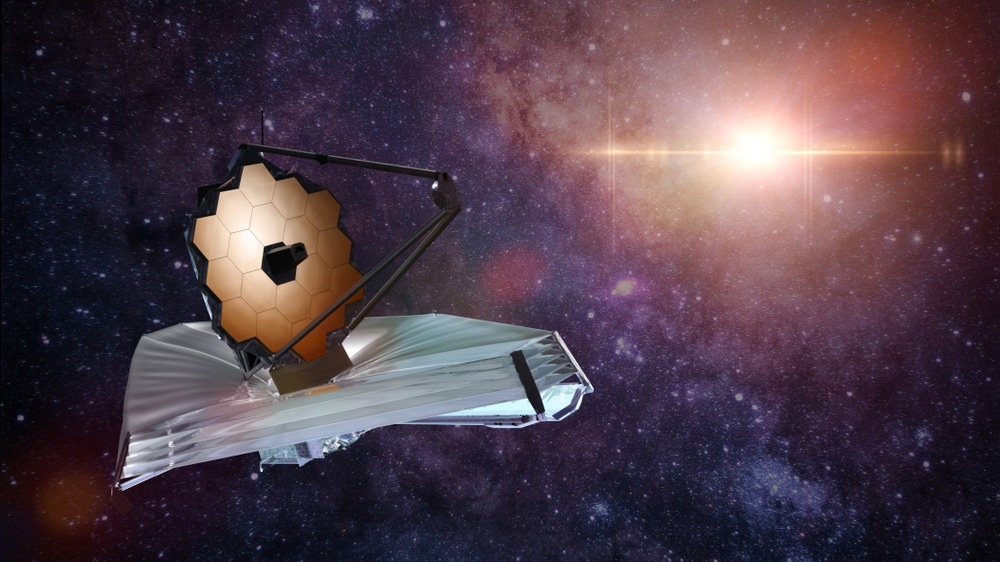 By Owais AliReviewed by Lexie CornerFeb 29 2024
By Owais AliReviewed by Lexie CornerFeb 29 2024Astronomers use spectroscopy to analyze starlight and unveil the elemental compositions of distant stars. This method disperses light to identify absorption and emission signatures, providing insights into the presence and abundance of elements across celestial bodies.

Image Credit: Dotted Yeti/ShutterStock.com
The Quantum Origins of Stellar Spectra
Spectroscopy harnesses the quantum properties of atoms, where electrons orbit nuclei at discrete energy levels. The electrons jump between these levels by absorbing or emitting photons, leading to the emission or absorption of light. The emitted or absorbed light's wavelengths (colors) act as a 'fingerprint' for each element. For example, sodium atoms emit yellow light, and neon emits red light.
Astronomers determine the quantity of an element in a star by assessing the width and intensity of spectral lines. Broader and darker absorption lines signify a higher presence of the element, while wider and brighter emission lines indicate more atoms of that element. The overall chemical composition of a star is derived from the relative proportions of various elements revealed in the spectrum.
However, the absence of certain spectral lines does not necessarily imply the absence of an element. For example, only the hottest stars exhibit helium spectral lines, as cooler stars lack the heat to ionize helium. The strength of spectral features is also influenced by quantum physics, requiring a physical model incorporating temperature, density, and pressure to accurately determine stellar composition.
Continuous observations track dynamic changes in spectral lines, revealing stellar evolution, element enrichment, and supernova events. Large telescopes extend spectroscopic surveys to distant galaxies, allowing a glimpse into cosmic history and the chemical evolution of the universe.
Early Spectroscopic Discoveries: Helium and Beyond
Spectroscopy emerged in the 19th century as scientists realized that colorful atomic emission spectra could reveal new fundamental constituents of matter. The application of this technique to sunlight marked a pivotal moment. In the 1868 solar eclipse, French astronomer Pierre Janssen and British chemist Norman Lockyer independently observed a vibrant yellow line in the solar spectrum using spectroscopes, leading to the discovery of helium.
In 1925, British-American astrophysicist Cecilia Payne-Gaposchkin used advanced spectrographs to demonstrate that hydrogen and helium constitute over 98 % of all atoms in the Sun and most other stars. This explains why stars shine white to the naked eye rather than bright emission lines of individual elements.
Subsequently, researchers investigated and analyzed the spectra of different stars to determine their structure and chemical makeup. These pivotal insights laid the foundation of modern astronomical spectroscopy.
Recent Research and Development
Reassessing Stellar Age and Chemical Makeup of Psc-Eri Stellar Stream
A study published in Monthly Notices of the Royal Astronomical Society investigated the chemical composition of the Pisces–Eridanus (Psc–Eri) stellar stream, approximately 420 light-years away in the Milky Way's disk.
Psc-Eri's proximity makes it an ideal setting/laboratory for studying star formation and evaluating chemical and dynamical evolution theories.
The researchers employed high-resolution optical spectroscopy from the McDonald Observatory and LAMOST survey data. The results indicated that the Psc–Eri stream exhibits a near solar metallicity [Fe/H] of approximately -0.03, with a metallicity spread of about 0.07.
The study also suggests that Psc–Eri is younger than previously believed, with an estimated age of around 120 million years, contradicting earlier assumptions of a 1 Gyr age. This deduction is supported by the rotation period distribution of its stars, aligning with the 120-million-year-old Pleiades cluster, and the abundance of lithium, indicating a consistent age of approximately 120 million years.
The Influence of Stellar Composition on Planet Building Blocks
In a recent study published in Astronomy & Astrophysics, researchers employed high-resolution spectroscopic surveys, APOGEE and GALAH, to analyze the impact of the chemical composition of stars on planet building block (PBB) composition.
The results revealed reliable metallicity and alpha content trends, confirming a bimodal PBB composition associated with thin, thick disk stars. The analysis also highlighted the potential impact of host star abundance on proto-planetary discs, particularly in relation to water content.
The study emphasizes the need for large, high-quality surveys to explore further the intricate relationship between stellar evolution, PBBs, and planetary systems.
Chemical Compositions of Diverse Stellar Populations in NGC 2808
A study published in Monthly Notices of the Royal Astronomical Society investigated stellar populations in NGC 2808, a massive globular cluster in the Milky Way, with a chromosome map (ChM) designed using ground-based U, B, I photometry and high-resolution @VLT spectra.
Traditional ChMs from Hubble Space Telescope (HST) photometry identified five main populations (A to E), while new ground-based ChM revealed multiple populations across a wider field and indicated a link between chemical composition and stellar positions.
The abundance measurements showed significant variations in carbon, nitrogen, oxygen, and aluminum among different stellar populations, while iron and nickel exhibited negligible variations.
This study offers a comprehensive chemical characterization of NGC 2808's stellar populations, shedding light on the intricate nature of multiple stellar populations in globular clusters. It challenges existing stellar evolution models, particularly the detection of an AGB star associated with populations D and E, suggesting that highly helium-enriched stars can evolve into the AGB phase, contrary to previous predictions.
The study enhances our understanding of stellar composition and multiple populations in globular clusters.
Stellar Compositional Analysis of KELT-9 and its Ultra-hot Jupiter
In a study published in Monthly Notices of the Royal Astronomical Society, researchers analyzed the chemical composition of the star KELT-9, hosting the ultra-hot Jupiter KELT-9b, to investigate potential planetary material effects on stellar surface composition.
The analysis suggested no strong anomalies in its elemental composition compared to similar stars in open clusters. The lack of deviations aligns with theoretical calculations considering photospheric contamination from KELT-9b's mass loss.
The research also dismissed the possibility of recent ingestion of Earth-mass exomoons, in line with calculations of satellite orbital stability.
This study provides a foundation for investigating chemical signatures of planetary mass transfer in the photospheres of other early-type stars susceptible to accreted material contamination.
The Next Generation of Stellar Spectroscopic Surveys
A new generation of sophisticated spectroscopic surveys will dramatically expand samples to millions of stars and galaxies. The Sloan Digital Sky Surveys and the James Webb Space Telescope will reveal compositions of stars around the Milky Way's supermassive black hole and stellar nurseries shrouded in thick gas clouds.
While the stars remain out of reach, spectroscopy offers profound insights into celestial objects, from nearby stars to ancient galaxies, revealing our cosmic origins.
More from AZoOptics: How is Infrared Spectroscopy Used in Astronomy?
References and Further Reading
Cabral, N., Guilbert-Lepoutre, A., Bitsch, B., Lagarde, N., Diakite, S. (2023). How the origin of stars in the Galaxy impacts the composition of planetary building blocks. Astronomy & Astrophysics. doi.org/10.1051/0004-6361/202243882
Carlos, M., et al. (2023). The chemical compositions of multiple stellar populations in the globular cluster NGC 2808. Monthly Notices of the Royal Astronomical Society. doi.org/10.1093/mnras/stac3561
Impey C. (2024). Stellar Composition. [Online]. Teach Astronomy. Available at: https://www.teachastronomy.com/textbook/Properties-of-Stars/Stellar-Composition/
Hawkins, K., Lucey, M., Curtis, J. (2020). The chemical nature of the young 120-Myr-old nearby Pisces–Eridanus stellar stream flowing through the Galactic disc. Monthly Notices of the Royal Astronomical Society. doi.org/10.1093/mnras/staa1673
Kama, M., Folsom, C. P., Jermyn, A. S., Teske, J. K. (2023). KELT-9 and its ultra-hot Jupiter: Stellar parameters, composition, and planetary pollution. Monthly Notices of the Royal Astronomical Society. doi.org/10.1093/mnras/stac3329
Montes, C. (2019). How do scientists determine the chemical compositions of the planets and stars? [Online] Astronomy. Available at: https://www.astronomy.com/science/how-do-scientists-determine-the-chemical-compositions-of-the-planets-and-stars/
Disclaimer: The views expressed here are those of the author expressed in their private capacity and do not necessarily represent the views of AZoM.com Limited T/A AZoNetwork the owner and operator of this website. This disclaimer forms part of the Terms and conditions of use of this website.